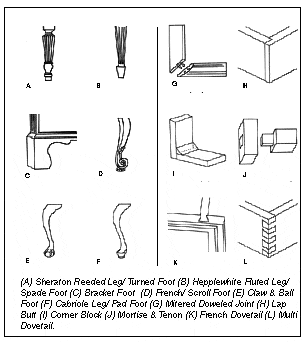
Dining Chair QualityThose seeking knowledge about dining room furniture should know that there is a fine glossary at the end of the article. The entire dining room furniture guide contains 16 pages of information on construction, styles and terms. The guide sells for $1.95 and can be purchased by calling FURNITURE WORLD Magazine at 914-235-3095 or email education@furninfo.com.
Quality dining chairs feel heavy, substantial and rigid. Chair quality is easy to see and demonstrate since every rail, post and joint is exposed and easily examined.
Chair comfort is one of the most important indicators of good design. You should demonstrate how the design of the seat, back and arms contribute to seating comfort. Make sure your customers sit in each chair they consider purchasing.
Chair strength is extremely important, since dining chairs often take more abuse than any other piece of household furniture. They get knocked over, stood on, spilled on and balanced on their back legs. Poor construction integrity resulting in loose joints will certainly cause customer dissatisfaction, or injury.
Fortunately, most dining chairs are very well made. Box seat wooden chairs often have mortise and tenon joints or dowel joints joining leg posts, stretchers, back posts and rails. Corner blocks are used at stress points to strengthen the seat and the joint, especially where stretchers are not used. All joints should be rigid and the chair should not wobble.
Sloppy joinery and the use of filler to smooth out joints is an indicator of poor quality, as is the excessive use of nails and screws to stabilize a wooden joint.
Different wood species do not expand and contract at the same rates. This may cause problems at joints where two species are joined - but not necessarily. There are many fine windsor chairs, for example, dating from the mid 18th century which combine Pine, Hickory, Oak, Ash and others in the same piece.
Steam bent parts will generally be stronger than shaped parts or those made from several components joined by finger and laminated joints.
Finish quality can be judged by examining places near joints or carvings that are hard to reach and so require hand sanding - especially on chairs with posts, pierced splats, slats or turned parts. These areas should be smooth, evenly stained and free from excess glue.
Bev & Mike
Landfair Furniture + Design Gallery
Dining Room Furniture Home Decor

 PowerBlog Review: Landfair Furniture
PowerBlog Review: Landfair Furniture



No comments:
Post a Comment